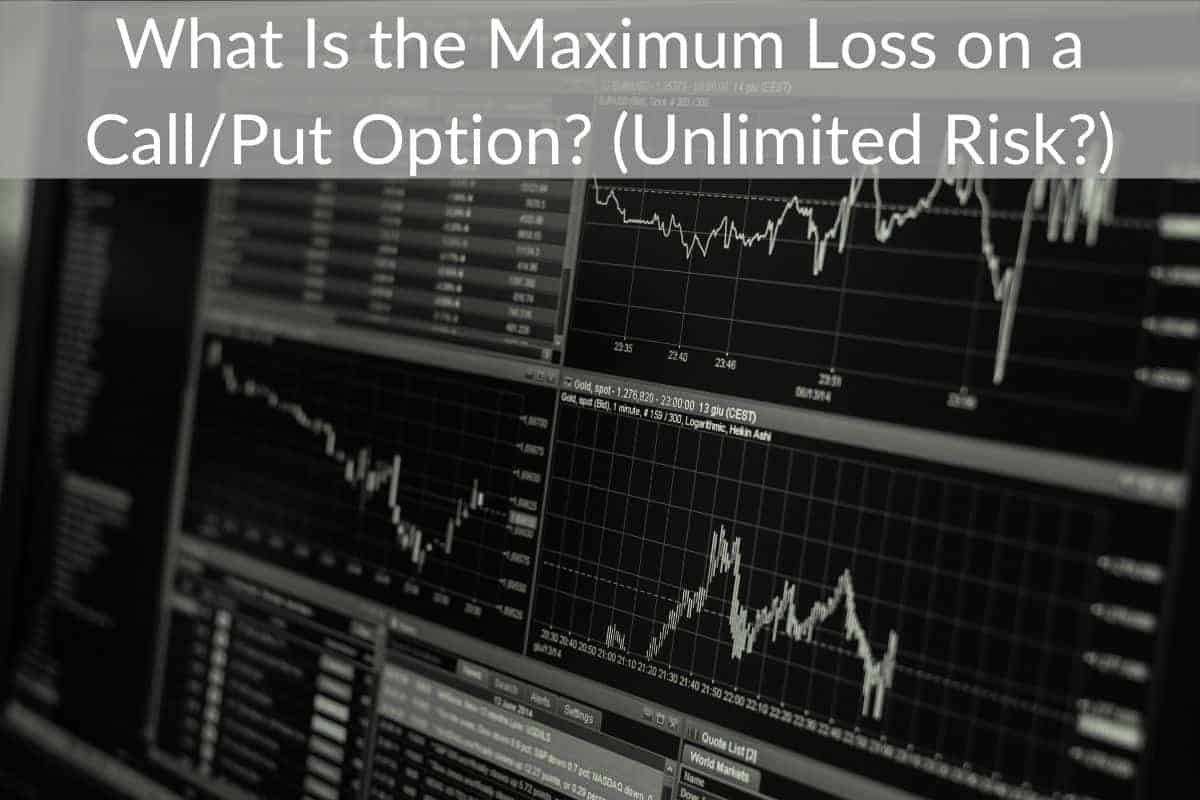Table of Contents
*This post may contain affiliate links. As an Amazon Associate we earn from qualifying purchases.
When dealing with investments, it’s essential to have all of your bases covered, which includes knowing the maximum loss on a call/put option. What is the maximum loss on a call/put option, or is there an unlimited risk?
If you are the buyer of the call or put option, your maximum loss is the premium that you paid. If you sold the call or put option, your maximum loss is whatever you paid for the stock (assuming it was a covered call or put). The exact amount depends on what you have invested.
The maximum loss on a call/put option varies depending on whether you are the buyer or the seller of the option.
It’s better to have your eyes wide open when you’re getting into the investment world. In this article, we’ll cover the finer details of your possible maximum loss so you can understand it a bit better.
Understand Your Maximum Loss On Call And Put Options
To understand your risk, you first need to understand your maximum loss precisely so you know what risk you are taking. This will determine the actions you take with your options during specific points.
What Is The Maximum Loss On A Call Option?
The maximum loss possible on a call option depends on whether you are the buyer or the seller. Each call option contract typically represents 100 shares of the underlying asset or stock.
If you are buying a call option your maximum loss is whatever you paid for the call option. If you sold a covered call then your maximum loss is whatever you paid for the stock (if it goes to zero which is unlikely).
The call option investor doesn’t have to own the underlying asset to buy a call however if you are selling the call then owning the stock is a good idea so that way you are “covered”.
A buyer of a call is simply paying a premium per share so if you don’t sell that call or exercise before it expires you will lose your entire premium.
A call grants the call buyer the right but not the obligation to purchase the asset upon its expiration at a predetermined price, which is known as the “strike price.”
The buyer of a call option can lose money when purchasing calls, but their loss is limited to the amount they paid for the initial call premium. Additionally, the purchaser of the call option has a possibility to receive limitless potential profit.
What Are The Potential Gains For A Call Option?
The potential gains for a call option seller won’t be anything more than the premium already collected. The loss to the seller could theoretically be the entire amount that they spent on the stock (although the stock going to zero is highly unlikely).
When buying a call option there is no limit to the possible potential gains. A stock could theoretically move 1,000% in a single day and as a holder of a call option you would get all of that appreciation.
Although it’s unlikely that a stock would increase 1,000%, call option premiums will absolutely live by that amount in a single day! So your potential upside with a call is extremely high.
Breaking Even On A Call Option
In order to reach a point where a call option buyer may break even, the price of the stock should increase to cover the strike price and the premium which the buyer has already paid.
That’s assuming that they hold the call option to expiration.
If instead the call option buyer buys the option to resell it in a few days or weeks their break even is just what they paid for the call in the first place (the option premium).
If selling a call option you will break even if the stock drops the same amount that you received in premium. So say for example you sell a call for $1 a share ($100 per call contract). You would break even if the stock drops by that dollar premium.
So selling a call helps to protect your downside but you are giving up your possible upside.
What Is The Maximum Loss On A Put Option?
By contrast, a put option is a contract that gives the owner of the stock, or underlying asset, the option to sell the stock at the strike price. Buying put options is a way to bet against a stock if you think that it will go down.
If someone believes that a stock’s value will decrease, they may consider buying put options for that stock.
The maximum loss when buying a put option is the premium you have already paid to buy it. The potential loss to the seller of the put option could be unlimited as it is equal to the amount of the asset’s market price or stock times the number of options sold.
What Are The Potential Gains For A Put Option?
The potential gains for the buyer of a put option are virtually unlimited (just like a call option) however the stock can’t go below zero so the gains are capped if the stock drops to that point.
The potential gains for a seller of put options are limited to their premiums for writing the puts.
Breaking Even On A Put Option
To reach a point where the buyer of the put breaks even, the stock’s price should decrease the amount of the strike price plus an additional amount totaling the premium paid to buy the put option.
That’s if held to expiration.
If a put option is bought and then resold on the open market prior to expiration, the breakeven is when the price of the put option is equal to the price that was paid.
Is There Unlimited Risk Involved When Buying Options?
If you are wanting to get into buying out or call options you will want to know what possible risk you can have. Is your risk when buying options unlimited?
When buying a put or call option the maximum amount that you can lose is the premium that you paid for the option. So if you spent $100 to buy a call option then the most that you can lose is that $100 premium.
Although you can lose 100% of the money that you invested in a specific call or put contact your risk is not unlimited as you can only lose the amount you spent when buying that put or call.
Which Option Has Unlimited Loss?
Now that you know that buying puts and calls does not have unlimited risk you might be wondering what option it is that actually does have unlimited risk.
The option with unlimited risk is selling naked calls. In this scenario you would sell a call to someone without owning the stock to back it up. If the stock price increases drastically you would be forced to buy the stock at market price no matter if that stock has gone up 5% or 5000%!
Therefore, selling naked calls are only considered appropriate for investors with thorough knowledge of investing and trading and is not something I would ever recommend.
You must also have a solid understanding of risk management and be very disciplined. A naked call occurs when an option is sold without owning any underlying asset or stock. Selling naked calls gives an investor the ability to generate income on an asset without owning any themselves but also leaves them open to massive amounts of risk.
Why Does Option Selling Have Unlimited Risk?
People often think that selling options (puts or calls) leaves you open to unlimited risk but actually this isn’t true.
The only option sellers that have unlimited risk are those that sell naked calls or puts. If you sell a covered call then your risk is limited to the amount that you spent on buying that stock.
Selling covered calls is safer since you actually own the stock. So if the call option is exercised and your stock is called away you have the shares to cover that.
What Could Be The Maximum Loss For A Seller Of Options Contracts?
Selling options is considerably more confusing to most people than buying them. Before you ever start to sell options it’s important for you to know what you are getting into.
The maximum loss for a call option seller (assuming they actually own the stock) is whatever they spent on the stock in the first place. The maximum loss of a put seller is the difference between the strike price that they sold the put at and what the price of the stock was actually at upon expiration.
As a put seller, you are obligated to buy the underlying assets when the buyer exercises his option so if you sold a put when the stock was at $45 and the stock dropped to $20 your loss would be $25 a share (minus the premium that you collected).
For a call seller (assuming it was a covered call) your maximum loss is determined by whether a stock price drops. If you buy a stock at $5 a share and it drops to zero after you sold a call then your maximum loss would be the $5 a share (minus the option premium you collected).
When selling both a call or put you keep the option premium no matter what happens with the stock price.
Are Options Risk-Free?
Options are not risk-free. However, low-risk or virtually risk-free options can theoretically be created by options arbitrage. Arbitrage, in investment terms, means to make multiple trades on one asset, simultaneously and for a profit.
An example of this might be buying an asset in one market for a low price, then selling the asset in another market where it is worth more. Realistically, arbitrage opportunities are more complicated than this, but this scenario can be an example.
Opportunities for options arbitrage are rare and are usually created by companies that possess analytical software that can locate such opportunities before any human trader has a chance to take advantage of them.
Conclusion
Before you begin investing in options, it’s best to have an idea of what your possible risks might be. Ensuring that you fully understand this will help you optimize your choices regarding your call and put options to maximize your potential gains.

